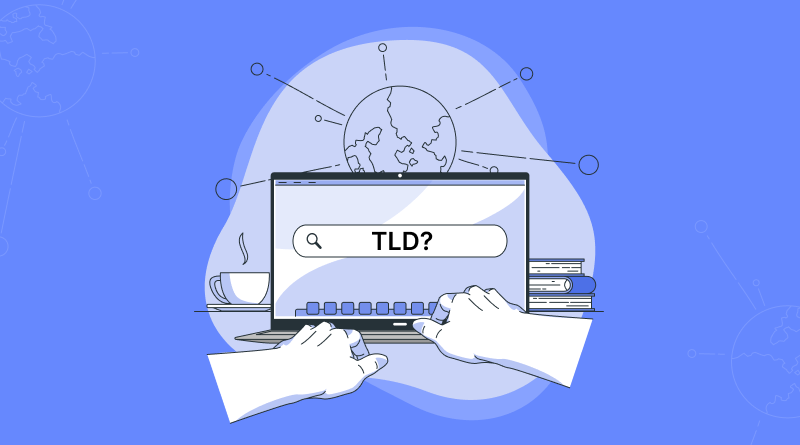We type .com, .in, or .org almost daily without much thought. Now picture this: there are more than 360 million registered domain names worldwide. Yes, that is more websites than the combined population of the United States and Canada.
It is extremely easy to type a URL in today’s society, as it has simply become second nature. We seldom reflect on what comes after the dot, whether it is a .com domain name, a .in domain name, or a .org domain name. That small suffix, a Top-Level Domain (TLD), is a hidden key that unlocks much more about a website than we typically imagine.
Now, what is a domain name? Simply put, it is the address of your website on the web and assists users in locating and accessing your specific site. Domain name registration allow us to access different websites because it means we do not have to memorize long lists of numbers, which are called IP addresses.
The TLD is the domain’s last part—its ending tells what type of website it is and where it comes from. Some common examples include .com (commercial), .org (organization), or .in domain name. Although TLDs seem like mere additions to domains, they play a significant role in determining the essence of the website, level of user trust, and even ranking on search engines.
In this blog, we will examine what a TLD is, its different types and examples, how it affects SEO, and why selecting the best TLD will make a difference for your online identity. Let’s begin.
Table Of Content
What is a Top Level Domain (TLD)?
A Top-Level Domain (TLD) is the last segment of a domain name. It defines the part that comes after the last dot. For instance, example.com has a domain of .com. This is an important part of a website address since it facilitates effective organization or routing of internet traffic.
TLDs are crucial in the Domain Name System (DNS). It is the internet’s phone directory. The DNS receives requests for numeric IP addresses corresponding to the entered domain names. TLD assists DNS in determining which server must respond to your request and is concerned with narrowing the query.
In broad terms, we can conceive the internet as a vast filing system. TLD is folders containing files that follow the same theme or subject matter. For example, education-related sites would go under the .edu folder and government entities with .gov.
ICANN (Internet Corporation for Assigned Names and Numbers) is in charge of globally managing TLDs through its non-profit organization IANA (Internet Assigned Numbers Authority). IANA oversees TLD domains alongside the allocation of a TLD’s domain name system, the root zone, which is an organized collection of all TLDs.
TLDs, in addition to assisting with domain name classification, allow users to effortlessly skim through relevant websites and form their personal insight about the site’s intended purpose. For instance, Japan is assigned a TLD of .jp and the USA has .us, while .com and .net serve as general identifiers for commercial and network websites, respectively.
Related Read: Domain Name Trends for Startups: .tech, .io, or .com? Best Choice for Businesses
Types of Top-Level Domains (TLDs)
Let’s start with understanding what is TLD in domain. With the rapid expansion of the internet, TLDs prove to be a major system for website organization. To aid users and computer systems in an easier identification of a website’s origin, purpose, or category, TLDs have been grouped accordingly. Additionally, these groups help maintain a well-running domain name system. The greatest categories include Generic TLDs (gTLDs), Country Code TLDs (ccTLDs), Sponsored TLDs (sTLDs), Infrastructure TLDs, and Special-Use TLDs.
We’ll break down the first and biggest group of gTLDs.
1. Domain Names With Generic Extensions (gTLDs)
- Definition: One of the clearest types of domain extensions used is gTLDs or generic top-level domains. They can be registered by anyone globally and are thus not restricted by country or region. gTLD domains are registered to serve a general purpose and represent their website’s nature or category.
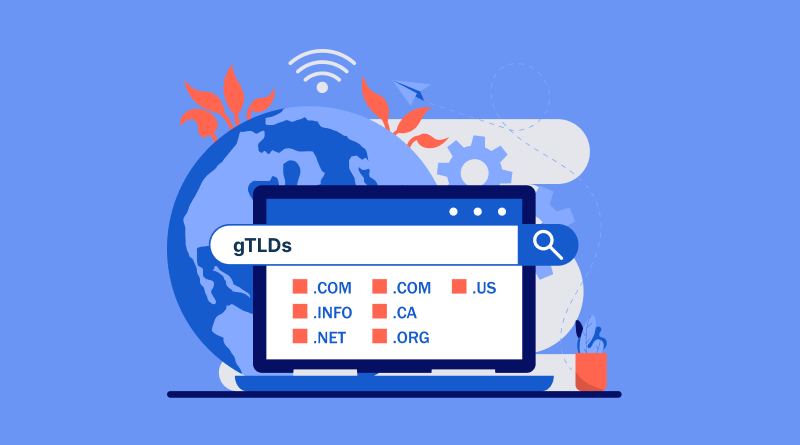
The most popular gTLD examples are as follows:
- .com: The most well-known type of domain across the world. Initially, it was aimed at commercially registered entities. Nowadays, it is used by blogs, businesses, and personal websites.
- .org: Though meant for non-profit organizations at first, it is now used by other entities, including communities and educational projects, as well as open-source projects.
- .net: Originally aimed at network service providers, it is now used commonly by tech startups and other companies.
- .info: It is predominantly used for knowledge-sharing portals and other educational websites to serve an informational purpose.
- .biz: This extension primarily aims at small business accounts, offering merchants and e-commerce platforms a less aspirational alternative to .com.
- .xyz: .online, .club, .site: These gTLDs are aimed at those looking for more expression and creativity, as they are more freely brandable and flexible compared to other less popular extensions.
At first, .com was used exclusively for identifying commercial services, but nowadays it has set the gold standard for every domain out there. A business will always want to establish its online presence with a trustworthy and well-liked website and .com has made that easy. Blogs, portfolio sites, and even non-profit businesses have now started using .com, as it has become an industry-standard domain signifying credibility and professionalism.
New gTLD examples:
- .tech: The preferred choice for IT experts, tech startups, and developers.
- .shop: The go-to for online retail and e-commerce brands.
- .blog: Best suited for content writers and bloggers.
- .app: Tailored for mobile applications and software firms.
- .photography, .design, .travel, .music: Specialized TLDs meant for certain industries or hobbies.
These new extensions allow the public, along with companies, to freely personalize and select domain names that represent their brand, trademark, or field of expertise. For example, a tech company could choose yourbrand.tech, while a travel blog might opt for wanderlust.travel. This enhances retention power and gives visitors immediate context about the website’s purpose.
Advantages of new gTLDs:
- Branding: Promote your brand with a unique domain name that incorporates your valid extension.
- Availability: When it comes to finding domain availability, new gTLDs far surpass older options like .com. The sheer number of unused names in new gTLDs provides much more choice than the heavily restricted .com space.
- CTR Empathy: Google still prioritizes .com domains but does treat all gTLDs equally when it comes to trust level or ranking, provided the content is genuine and good.
2. Country Code Top-Level Domains (ccTLDs)
- Definition: These are two-letter domain endings allocated to specific countries, sovereign states, or areas; country code top-level domains, which are referred to as ccTLDs. Derived from the ISO 3166-1 alpha-2 benchmark, they are generic TLDs, but unlike basic domain gTLDs, they serve to focus on projects, geos, and regions, not just specific geographical coverage. Each ccTLD is set up in the trust of the relevant country authority or registry.
- Purpose: ccTLDs serve as territorial identifiers focusing on country and regional naming purposes for the web. A website using .in is suggestive of being based on or consuming attention from Indian users, and similarly, a .co.uk domain name from the United Kingdom. These extensions allow easier user access to region, language, or local service-related websites.
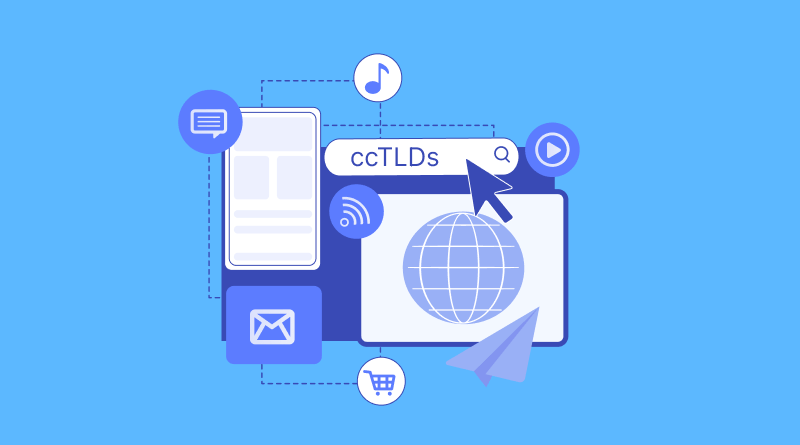
Examples:
- .in: India
- .ae: United Arab Emirates
- .uk: United Kingdom
- .us: United States
- .de: Germany (from “Deutschland”)
- .jp: Japan
- .ca: Canada
- .fr: France
Advantages of new ccTLDs:
In regard to a specific country or region, ccTLD offers special strategic benefits for business organizations and content creators:
- Enhances Local SEO Strategies: Search engines such as Google identify the ccTLD as a firm indication of geographic relevance, which can improve visibility in search engines’ local listings.
- Audience Engagement: The ccTLD adds to the trust that the website is culturally as well as operationally local in nature, thus enhancing user trust, engagement, and participation.
- Compliance with Legal and Regulatory Policies: The use of ccTLD can aid in ensuring compliance with the local laws regarding privacy, digital data, and e-commerce.
- Domain Hacks/Unpredictable Applications: While typically tied to specific countries, many ccTLDs have transcended their geographical basis to become the backbone of “domain hacks.” These innovative domain names creatively weave the ccTLD into a word or phrase, demonstrating remarkable ingenuity in crafting catchy and distinctive web addresses.
A few examples of ccTLDs:
- .co: Initially a Colombian ccTLD, it is now widely accepted shorthand for “company” or “corporation.” It is also preferred as an alternative to .com.
- .ai domain name: Designated to the small British territory of Anguilla situated in the Caribbean but additionally embraced by the industry of Artificial Intelligence booming (e.g., open.ai, copy.ai).
- .me: The country code top-level domain (ccTLD) for Montenegro, commonly used in personal branding websites (e.g., about.me).
- .tv: Currently used by video streaming and entertainment platforms due to the “TV” association, even though it belongs to the island nation of Tuvalu.
- .io: Although the .io domain was originally intended for use in the British Indian Ocean Territory, the domain has been widely adopted by tech startups, especially in the software and SaaS sectors, because of its association with “input/output.”
3. Sponsored Top-Level Domains
- Definition: Sponsored Top-Level Domains (sTLDs) are domain name extensions that are controlled by a particular organization or sponsor representing a designated community, whether professional, governmental, ethnic, or geographic. These sponsors help to establish and enforce strict rules regarding the use and registration of the domain. Unlike generic TLDs, sTLDs are marked with proof of membership within the community, thus restricting registration to those who fulfill specific criteria.
- Purpose: The main focus of sTLDs is to provide domains to communities with common interests or objectives. They enhance credibility and trust since only qualified organizations can own these domains. This helps the users to easily identify credible and relevant sources in particular domains.
sTLD examples:
- .edu: For secondary education institutions, mainly located in the U.S. and sponsored by Educause, postsecondary educational institutions need to be accredited. Stemming from the trusted domains for education, it is highly reliable for academic resources.
- .gov: Dedicated to U.S. government agencies and sponsored by the General Services Administration (GSA). It guarantees government authentication.
- .mil: Sponsored by the U.S. Department of Defense for the United States military, it denotes sites associated with defense.
- .aero: For the undifferentiated air transport industry, it was sponsored by SITA so it can also be used by airlines, airports, and aviation professionals.
- .coop: Stands for cooperative associations and was sponsored by DotCooperation LLC to showcase community-owned business models.
- .museum: Administered by the Museum Domain Management Association (MuseDoma), it is used for cultural institutions and museums.
- .travel: Managed by Tralliance Registry Management Company, it is for use by those in the tourism and travel industry.
- .art domain: Managed by UK Creative Ideas Limited, this domain is dedicated to individuals, organizations, and businesses within the arts and creative industries.
4. Test Top-Level Domains (tTLDs)
- Definition: As the name suggests, Test Top-Level Domains serve the purpose of testing and experimentation. These TLDs cannot be resolved through the Domain Name System (DNS) and therefore don’t serve any purpose on the public internet. They are intended for developers and engineers working in a controlled environment.
- Purpose: The main aim of the above tTLDs is to guarantee safe and conflict-free development and documentation. Employing these reserved domains helps. Developers ensure that they do not inadvertently interrogate or query actual sites. Examples devoid of real-life consequences or interaction with the outside world abound. Internal environments without exposure to the Internet can be maintained by organizations. These domains are registered with IANA (Internet Assigned Numbers Authority), which does not resolve them under public DNS, ensuring there is no restriction on testing made across platforms.
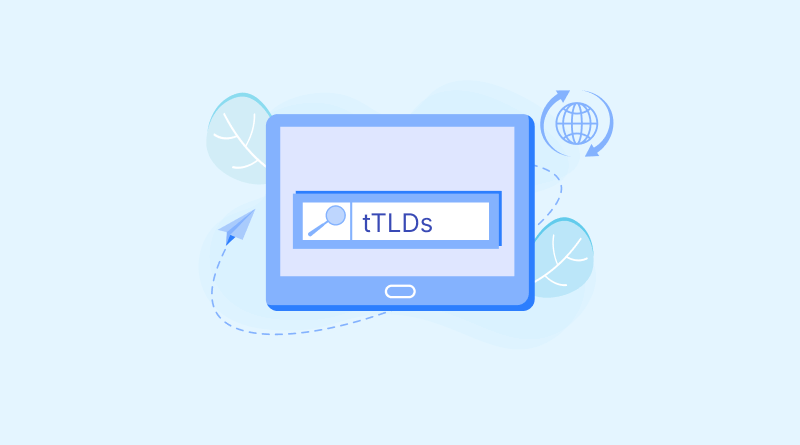
Examples:
- .test: Used within staging environments to steer clear of clashes with genuine domain names.
- .example: Mostly found in documents and other teaching materials meant to illustrate domain structures without any risk of being hacked.
- .invalid: Indicates that a domain name is certain to be invalid in DNS. Handy when an erroneous domain is required for error handling or testing purposes.
- .localhost: Points to the machine in question. Common in software development for use in internal testing, server, and software development environments.
5. Reserved Top-Level Domains
- Definition: Reserved Top-Level Domains are TLDs that have been permanently set aside for exclusion under global DNS. The aforementioned domains are set aside by IANA for some reasons – most frequently to curb misuse, masking, or technical hits.
- Purpose:
- Reserved TLDs are crucial for:
- Network isolation: Providing support for internal services that should not be accessible from the open internet.
- Security and privacy: Protecting domains like .local or .onion from being unintentionally made visible or reachable from outside.
- System compatibility: Permitting software and hardware designers to base assumptions on the existence of overlapping zones in some specialized cases.
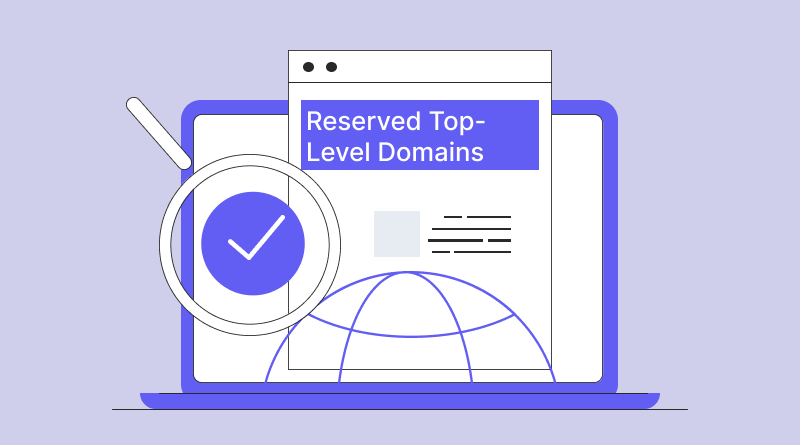
Examples:
- .local: Commonly appears in local network setups, notably in internal DNS configurations such as Multicast DNS (mDNS). It is preserved to prevent interaction with global DNS when applied to private or home networks.
- .onion (not strictly in DNS, but used within the Tor network): Enables anonymous accessibility to services over the dark web. It is also thought to be reserved to avoid regular DNS interference.
Summary of Top-Level Domain (TLD) Types and Their Characteristics
| TLD Type | Definition | Examples | Purpose | Availability |
| Generic TLDs (gTLDs) | Open-use domains available to anyone, regardless of location or industry | .com, .org, .net, .info, .biz, .xyz, .online, .club | General-purpose use; initially designed by category but now widely used | Publicly available |
| New gTLDs | Recently introduced industry-/purpose-specific TLDs | .shop, .tech, .blog, .app, .guru, .design | Branding, niche targeting, and differentiation | Publicly available |
| Country Code TLDs (ccTLDs) | Two-letter domains tied to specific countries or territories | .in (India), .uk (UK), .us (US), .de (Germany), .jp | Target regional audiences, support local SEO, build trust | Generally restricted to locals |
| Creative ccTLD Uses | ccTLDs used for branding or domain hacks beyond their original geographic intent | .co (Colombia), .ai (Anguilla), .tv (Tuvalu), .me | Creative naming, tech startups, personal branding | Publicly available (some limits) |
| Sponsored TLDs (sTLDs) | Managed by organizations representing specific communities or sectors | .edu, .gov, .mil, .aero, .coop, .museum, .travel | Represent verified entities, offer credibility in specific sectors | Strict eligibility requirements |
| Infrastructure TLD | Special-use TLD for technical infrastructure purposes | .arpa | Supports reverse DNS lookups and other internet infrastructure functions | Not available for registration |
| Test TLDs (tTLDs) | Reserved for development, documentation, and testing use only | .test, .example, .invalid, .localhost | Prevent DNS conflicts, enable safe testing in isolated environments | Not available for registration |
| Reserved TLDs | Permanently reserved and excluded from DNS to avoid misuse or conflicts | .local, .onion | Internal networking, system-level services, or specialized privacy-focused use | Not available for registration |
Real Life Examples of Top-Level Domains
The following TLDs illustrate how they are utilized in the real world:
- .com: Domain used by large commercial corporations that operate on an international level.
- Examples: Google.com, Amazon.com
- .org: The domain of choice for many non-profit and community-oriented organizations.
- Examples: Wikipedia.org, RedCross.org
- .net: Originally intended for network-related businesses but has broadened in scope.
- Example: SlideShare.net
- .edu: Used only by post-secondary educational institutions accredited in the United States.
- Examples: Harvard.edu, Stanford.edu
- .gov: Used solely by government agencies, it therefore carries trust and status.
- Examples: India.gov.in, USA.gov
- .in: A country code TLD for India, used mostly by Indian businesses and services.
- Examples: Zomato.in, Flipkart.in
- .uk: Countries with a target audience scope for the UK.
- Examples: BBC.co.uk, Gov.uk
- .shop: New gTLD for fashion eCommerce retailers aimed at clearly marking the site’s intention.
- Example: Fashionista.shop
Does the Top-Level Domain Affect SEO?
Around the time a website is being developed, one of the frequently asked questions is: is there any impact on search rank as a result of using a specific Top-Level Domain (TLD)? The response is no, but there are several noteworthy indirect consequences to consider regarding SEO.
– Direct SEO Impact
It is no secret that TLDs, in particular, do not have a direct effect on the ranking of a website on Google. To illustrate, a site with a .xyz domain and an accompanying compliant SEO strategy will rank just as well as another site vying for the same keywords with a .com domain, provided both websites boast quality content and robust backlinks. Relevance, authority, experience, and user satisfaction far outweigh domain extension considerations.
– Indirect SEO Factors
Though TLDs do not bestow a competitive edge in ranking, they undeniably impact SEO through behavior and trust signals.
- Trust & Credibility: They evoke confidence and trust from users who are accustomed to domains ending with .com or .org or even well-known ccTLDs like .in or .uk. That trust is crucial in improving CTR, as it reflects positively on your website’s visibility in search engines.
- Brandability & Memorability: An ideal TLD makes brand recognition easier while increasing the chances of the domain being remembered, clicked, shared, and revisited, which helps overall visibility and engagement.
- Geographical Targeting: ccTLDs such as .in or .ca bear a stronger connotation of local relevance. Google tends to leverage that information to tailor results for a particular region, thus giving local firms an advantage in geo-targeted searches.
- Keyword in TLD: While a TLD like .blog or .shop may help express your niche, it does not provide an SEO benefit on its own. Content quality, user experience, and link authority remain far more critical.
- Avoiding Spam TLDs: Certain less-known or mismanaged TLDs have in the past been associated with spammy activities. While Google is now treating TLDs with more neutrality, user skepticism may still impact CTR.
Does It Matter What Top-Level Domain You Choose?
It matters how you choose your top-level domain (TLD), even if it does not instantly affect your SEO ranking. Your TLD is an essential part of your digital persona and shapes your online identity and how visitors will view your site and brand.
– Brand Identity & Recognition
The brand is presented and recognized using the domain name, i.e., the extension serves as an identifier. Users tend to feel safe as well as find www.example.com professional and well-known. On the other hand, those who are more niche or recent do help promote your brand focus.
– Trust & Credibility
Certain TLDs are known to be affiliated with a specific type of legitimacy. For instance, .edu or .gov presents authority to the name, while the rest of the world’s country code top-level domains (ccTLDs), such as .in and, .uk garner trust from the local audience.
– Target Audience
With the appropriate TLD, it becomes easy to identify the intended target for a specific website. A ccTLD, for instance, focuses on visitors to a specific country, unlike domain-specific TLDs like .tech or .shop that cater to specific interests.
– Availability
If you are looking for domain names in .com, chances are the name you are looking for is unavailable. Looking into other extensions could lead you to a fantastic and catchy domain name.
– Cost Considerations
Multiple fees are associated with TLD registration and renewal and they differ significantly. Some sponsored or specialty TLDs might cost more, so it is necessary to balance cost considerations with branding needs. Also, reliable domain name service providers ensure you get multiple domains registered at the best costs.
Your online identity is shaped by the domain name you choose and a Top-Level Domain (TLD), the last part of a website TLD, is essential for you to determine your identity online. Establishing a brand perception requires trust, enabling you to focus on other aspects of business, which makes TLDs vital despite the fact that they do not influence SEO ranking directly.
Clarity in targeting the audience is critical, making TLDs essential. Trust can only be earned when carefully targeting the desired audience and building a reputation.
Selecting the most informative TLD allows users to identify the type of service, specialized industry, or whether it’s a local or global business. Balance your long-term goals alongside audience expectations to correctly brand your value.
Understand that domain extension choices require critical judgment because they transcend being mere web links and serve as a pillar for your online identity.
FAQs
What is the importance of a TLD?
The defining purpose of a TLD is to give an identity to a website’s purpose and its audience. It impacts the way users perceive credibility and professionalism and helps define geographic or industry targeting. It is crucial to mention that the right TLD impacts trust, brand recognition, and even local SEO for country-specific domains.
How do you create a TLD?
A new TLD requires a lot of technical work as well as resources to deal with and is heavily controlled/managed by ICANN. During designated application windows, several entities must apply and submit complex, detailed, technical, and legal documentation related to finance. The applicant, after being approved, becomes the registry operator, which means they control all functions of the new TLD. This entails hundreds of thousands of dollars and months, years, and sometimes even longer to complete everything.
How to reserve a unique URL?
First off, head to MilesWeb’s ai domain search website and using the search bar, look for the domain name of your choice. Now, select the TLD option of your preference. Once done, complete the registration process by paying the applicable fee. That’s it; now you can use the registered domain freely and renew it every year.
Which TLDs are restricted for use?
Examples of restricted TLDs are .gov, .int, .edu, .mil, and sponsored ones such as .aero or .museum. These domains are provided only to certain government establishments, learning institutions, or specialized certifying bodies that comply with higher standards of eligibility review. They cannot be registered by any member of the public.
What are most top-level domains used for?
The most prominent top-level domains used are .com, .org, .net, .in, and .co. Of all, .com is the most noteworthy, as it has the strongest reputation along with recognition across the globe. Other country code TLDs used most widely are .de for Germany and .uk for the United Kingdom, which serves regional companies and frameworks.
Which TLDs are restricted for use?
Some TLDs, such as .gov and .mil as well as .edu, are confined to certain vetted institutions. For instance, .gov is an exclusive domain for American state institutions, and .edu is reserved for institutions of higher education in America. Such limitations help guarantee domains from highly regulated industries remain reliable and trustworthy.

